Table of Contents
Zebra Pleco Fish Overview
Sometimes it can be really difficult to choose the right species of fish for your tank. In this article, we will discuss one of the fish species, which is Zebra Pleco. We are going to discuss catfish Zebra Pleco, which is also known as The Zebra Plecostomus.
They aren’t readily found in the fish pet market because of their unique design and appearance. However, these beautiful fishes are easy to care for and add a beautiful look and feel to your home aquarium.
Even though they are a type of lone fish that likes to keep to themselves and swim around in the tank, exploring the surroundings, you will soon find yourself entranced by their appearance and personality.
Since the Zebra Pleco is quite an underrated and unknown type of aquarium fish, we want this care guide to be a one-stop solution to all your questions and queries concerning this fish.
| Information Chart | Zebra Pleco |
| Scientific Name | Hypancistrus zebra |
| Family | Loricariidae |
| Care level | Easy |
| Temperament | Territorial but shy |
| Color | Black and white stripes |
| Lifespan | 10-15 years |
| Size | 3-4 inches |
| Diet | Omnivores |
| Minimum tank size | 20 gallons |
| Temperature | 79°F to 88°F |
| Water conditions | Freshwater with strong current |
| Tank mate compatibility | Peaceful |
Zebra Pleco Appearance

As the name suggests, Zebra Pleco has its distinct black and white striped appearance, mimicking a zebra in the wild. The stripes run laterally and give them a vivid and vibrant look when they are inside the tank when they come under the focus on the bright lightning.
Besides the color scheme and exterior appearance, the Zebra pleco has a typical body structure like the other plecos, including the standard flat bottom. The under-turned sucker mouth is accentuated with four whiskers to sense the surroundings and prepare themselves for any threats around.
Despite the small head, these small stripey fishes come with big bulbous eyes that seem to be out of the socket, giving them their quirky appearance. The triangular dorsal fin is mesmerizing to look at and stands tall out of the other shorter ray fins.
Aside from that, the fish has two sets of pectoral fins down the side that helps them with longer strides while swimming. There is the appearance of short hair-line rays around the head, especially visible in the male fishes.
Lifespan of Zebra Pleco
The typical lifespan of a Zebra Pleco is between 10-15 years, which is considerably a lot. However, their lifespan depends on the care and the kind of tank maintenance the aquarist indulges in.
They are easy to maintain; however, you need to regulate their water tank to mimic their natural habitat, so they feel comfortable growing in captivity. However, like any other freshwater fish available, even they are at risk of premature death due to incompatible tank mates or lack of access to premium quality food.
Zebra Pleco Size
The size of an average fully-grown Zebra pleco is between 3-4 inches, which is comparatively smaller than some of the other species of plecos.
While that might not mean much, it does prove to be a little challenging when trying to find compatible tankmates for them. Avoid putting them in a community tank that consists of fish that are larger than them.
Natural Habitat and Origin
This catfish is found in the river Xingu in Brazil. These species are a little bit hard to get hold of, but still, you can find some for your tank. The rarity of this freshwater catfish species is what makes them such a pricey aquarium fish.
As mentioned, they originated in River Xingu, which is a small tributary in the Amazon River. They are rarely found because of their reducing population in their natural habitat due to stunted reduction in the water flow.
They thrive in strong water currents, so any changes to their water parameters can put them under stress and drastically reduce their population. The population of this catfish drastically dropped following the construction of the Belo Monte Dam. This is why the Brazilian government has now banned the export of this fish because they are focusing on replenishing the lost population.
Even though the Zebra pleco was first identified in the 1990s, it is very bad to think that the fish quickly became endangered due to human interventions. However, the numbers are gradually ramping up again.
Also, these are bottom feeders in the tank and are nocturnal, so don’t be surprised if you don’t find them active during the daytime.
Zebra Pleco Care and Tank Set up
Taking care of a zebra pleco isn’t as complicated as you’d think. In fact, like most of the other South American species, even zebra pleco has similar tank conditions and needs. However, since their availability is limited, you want to be vigilant of the tank setup and the water parameters to give them the best life possible.
Zebra Pleco Tank Size and Specification

Optimum Tank Size for Zebra Pleco
Given that they grow up to a maximum size of 4 inches, a 20-gallon tank is more than enough to house them.
However, most of the advanced aquarists will suggest that you place them in a 30-gallon tank with a few other fishes of the same kind of compatible tank mates so they can live in harmony.
Filter Type
As we mentioned before, zebra pleco requires a heavy water stream and current to survive. So, when mimicking the same in captivity, you need to be very careful of the type of filter you are using. Generally, a powerful canister filter is an ideal option because it maintains a steady stream of water and ensures a comfortable living condition for these plecos.
If you can’t get your hands on the canister filter, the standard hand-on back filters get the job done as well. The only setting in the filter that you need to put up with is the strong current to enable the plecos to lead a comfortable life.
Substrate
Another part of the tank care worth mentioning for the chocolate zebra pleco is the substrate. Since these are bottom feeders in the tank, you need to be extra mindful of the substrate you put in.
Ideally, sand is the most preferred aquarium substrate, primarily because that is what’s found in the wild. Besides sand, you can throw away some big pieces of gravel. Avoid smaller pieces because that can prove hazardous for the fish.
Besides the substrate, you also need to space out many hiding spots in the tank because they like to have their alone time now and then to relax, especially during the day since they are nocturnal fishes.
How many Zebra Plecos should be kept in 20 gallon tank?
Since the 20-gallon tank is the standard or minimum requirement, we’d recommend that you keep a few zebra plecos in the tank. Don’t overdo it.
The Colombian Zebra pleco isn’t a schooling fish, and they often like to keep to themselves. However, keeping them with their kind makes it easier for them to stay with a completely different species.
Water Parameters for Zebra Pleco
Now that we have a fair bit of idea about the tank landscape and set-up let us move on to the water parameters. This is the quintessential part you need to stay focused on, especially as a beginner-level aquarist with minimal knowledge.
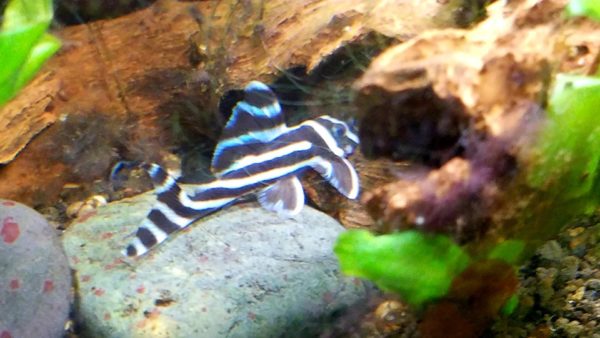
Your only aim is to mimic the ideal water conditions that its found in the River Rio Xingu. If you can manage that, there are no risks of premature death or other complications that many of the zebra plecos tend to face in captivity.
Water temperature
The ideal water temperature for a Zebra pleco should be between 79°F to 88°F. Try to aim for constant water temperatures somewhere in the middle of the desired temperature mentioned. We’d recommend relying on the natural sunlight or a dimly lit aquarium overheat light to attain that temperature.
pH level
The perfect water pH level for Zebra pleco is between 6.5 to 7.0. This suggests that the water needs to be slightly acidic to neutral, so you don’t have to do a lot to achieve that.
Water hardness
The water hardness level for zebra pleco is 2-6 KH.
Since the chocolate zebra plecos are very susceptible to changes, you need to keep an eye out for them during the first few days in captivity. Be vigilant of the water parameters and check them from time to time to ensure that the fish is comfortable in its new habitat.
Zebra Pleco Tank Landscape
Moving ahead to the decorations and the overall tank landscape, there’s not much you need to do.
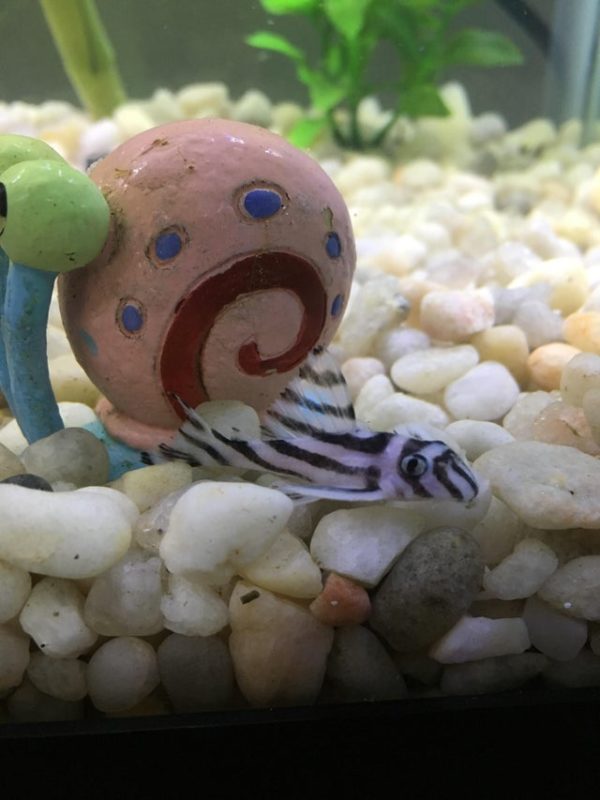
However, the only prospect you need to be cautious of is the structure of the items you put in. Since they are bottom feeders, you should stick to substrates that have a smoother outer surface. Anything jagged or sharp on the edges will hurt the fish when they are swimming.
Plants for Zebra Pleco Tanks
Zebra plecos aren’t very picky about the vegetation surrounding them. However, we’d recommend that you stick to live aquatic plants that won’t obstruct their movement around. The best option would be to ask around in the aquarium market, and they should be able to guide you about the ideal plants you should keep in the tank.
Decorations for Zebra Pleco Tanks
Yes, you do need to add a few decorative pieces to the tank. However, also make sure that they serve a functional purpose too.
Take the small caves and houses, for example. You need to add them as a decorative piece, but they also support the movement of the zebra plecos when they are tired and want somewhere to relax.
Also, it doesn’t matter whether you are introducing a live aquatic plant or even a store-bought cave in the tank; you must quarantine them before placing them inside the tank.
Lighting for Zebra Pleco Tanks
Since the zebra Plecostomus is a nocturnal freshwater fish, you want to keep them in low-light tanks. It’s okay to keep the aquarium light switched on during the daytime when they are hiding or sleeping; however, make sure you switch off the lights during the night when they come out and play in the tank.
Feeding Zebra Pleco
Zebra plecos are omnivores and bottom feeders. They also need to consume protein-rich food for a healthy diet. Also, when you first get Zebra Pleco, you should pay attention to their food intake as they are shy and will avoid eating food.
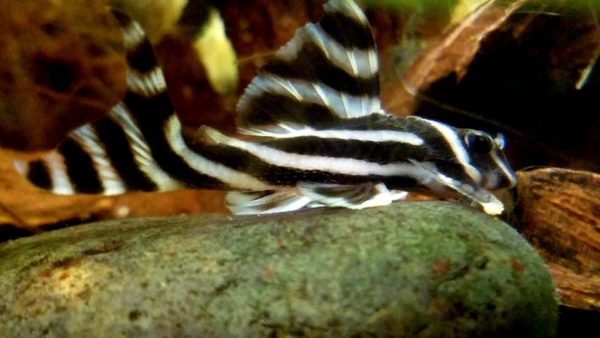
You can feed them with frozen and live food such as blood worms and brine shrimp. However, it is better to feed them with live food.
As for vegetables, you can feed them with crushed peas with the skin removed zucchini. Although they are not eager algae eaters, you can give them algae wafers as well. It is recommended to feed Zebra Pleco about 2-3 times per day.
Unlike the other plecos, these aren’t voracious algae eaters, which is one of the reasons why you should clean their tank every time possible. Also, since they are bottom feeders, you need to invest in pellet-based foods that will sink to the bottom of the tank instead of flakes that float on the surface.
If you are keeping your zebra pleco in a community tank, you need to feed them in a quiet spot in the tank where they feel comfortable to be. Some aquarists even recommend feeding them in a separate tank if not in a community tank.
Zebra Pleco Behavior and Temperament
If you are looking for a particularly active fish in a tank that will keep you entertained, zebra plecos aren’t the ones for that. They are timid in a new environment and often like to keep to themselves and hideaway in the caves and behind the rocks.
Also, they are nocturnal fishes, which means that they will not do much of anything during the daytime. They will either laze around in the bottom of the tank of sleep during the day. During the night, they come out of their shells and explore the tank and even interact with a few other fishes in the tank.
Although the female zebra plecos keep to themselves, you need to watch the male ones. They do get territorial and can start a fight with other male zebra plecos in the same tank. Fin nipping and aggression is common sign in those cases. If you are housing more than one male zebra pleco in a tank, invest in a larger capacity tank.
Are Zebra Plecos lone or societal in Nature?
They are predominantly lone and like to stay by themselves in the tank.
Zebra Pleco Tank Mates
Zebra plecos don’t like fighting for their space and food. So, when choosing tank mates for them, you need to be mindful of these two factors. If they feel threatened in an environment, they will show signs of aggression or restlessness, both of which contribute to premature death.
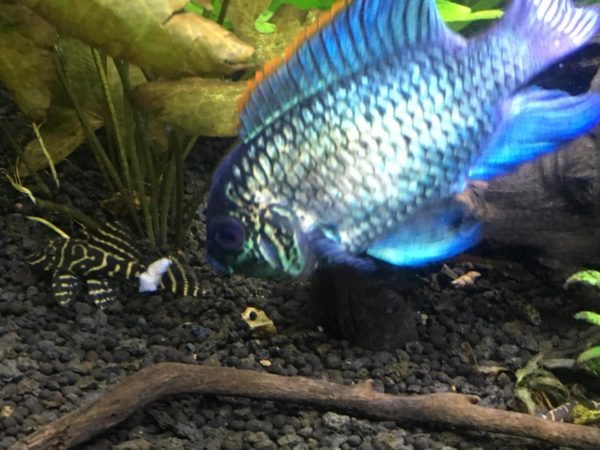
Since they are bottom feeders and like to keep to themselves, look out for smaller freshwater fishes that dwell in the middle or top of the tank. This way, there are no fights about space or dominance in a tank, and everyone lives a happy coercive life.
Also, be mindful of the size. Compared to other catfishes, Zebra plecos are comparatively smaller. This puts them at risk of getting eaten by larger fishes. So, pair them with tank mates that are similar or smaller in size to them.
Lastly, while choosing tank mates for the Colombian zebra pleco, you need to be mindful of the water parameters. Zebra plecos require a strong water current. This means that if you out a fish that prefers a slower stream of water, they won’t survive. So, make a checklist of all the requirements before choosing a tank mate for zebra pleco.
Some of the ideal tank mates include:
- Celestial pearl danios
- Cherry shrimp
- Bumblebee goby
- Ember tetra
- Harlequin rasbora
- Cory catfish
- Zebra otocinclus
- Snails
- Platies
- Kuhli loach
- Cardinal tetra
- African Leaf Fish
Some of the bad tankmates for Zebra pleco are:
- Rainbowfish
- Threadfins
- Hatchetfish
- Endlers
Whatever your choice of a tankmate is, always make informed decisions. Learn about the compatibility, water requirements, and overall behavior and temperament before you pair them together.
Breeding Zebra Pleco
Distinguishing a male zebra pleco from a female one is quite complicated. The only stark difference is in the head shape and the tiny hair-line rays prominent in the male zebra plecos.
During the breeding, female Zebra Pleco bears eggs in its belly. Usually, in the wild, these species breed during the rainy season between July to September. But, if kept in aquariums, they can breed any time. When breeding, the fish should have many hiding places in the tank. And you should often change the tank water.
For better breeding, the temperature in the tank should be raised to 82 degrees Fahrenheit, and you should use good air pumps to increase the oxygen level in the tank.
Zebra Pleco lay around 15 eggs in a cave-like are and the male watch and fry the eggs.
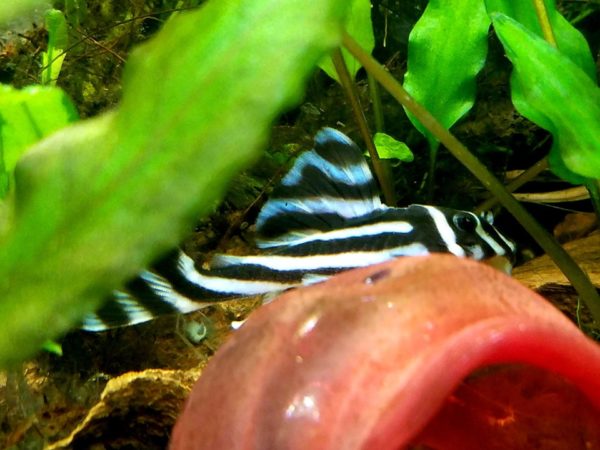
Once the eggs are laid by the female zebra pleco, the male one stays behind to guard the eggs and protect them from potential threats. The eggs generally take between 3-7 days to hatch into fry. You need to leave the babies alone for the first few days because they get their nutrition from the egg sac.
Following that, they need to be fed with powdered fry food, followed by brined shrimp a few weeks later.
Zebra Pleco Diseases and Treatment
Zebra plecos are pretty healthy fish species, but they sometimes get bacterial, parasitic, and fungal infections.
The best way to prevent that from happening is to treat the tank water now and then with anti-bacterial treatments.
Also, to keep the fish in good health, you need to change 20% of the water every few weeks. From time to time, the infections may happen because of warts. So, make sure that you clean the water when it starts becoming too cloudy to look at from the outside. Also, invest in a powerful filter to keep the water in the tank clean and liveable.
Also, be aware of introducing copper-based equipment in the tank because the zebra plecos don’t respond well to copper as other fishes.
Is Zebra Pleco Right For you?
Zebra Pleco is a relatively expensive fish species. And it can be a little difficult to buy them as they are not always present in all the stores. But still, it is possible to get them from fish stores and in online shops as well.
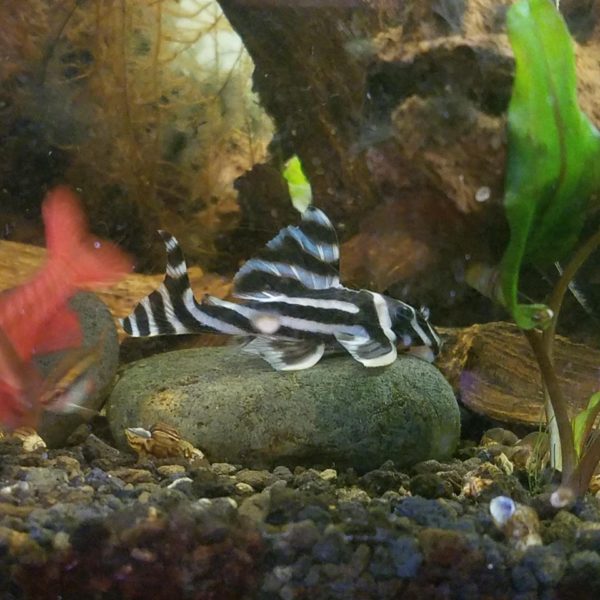
When buying these species of fish, be careful to choose healthy ones. As they are rare to find, sometimes there can be some not active and bad-tempered fish in shops.
Whether or not they are the right fish choice for you completely depends on what you are expecting. If you want to invest in an exotic and endangered fish species, zebra plecos are a good option. Although not the most accessible, they are easy to take care of. So, you can keep them in your home tank as a beginner as well.
FAQs
Are Zebra Plecos hardy?
Yes, if you can maintain the water parameters and tank set up as per their natural habitat, zebra plecos can live up to 15 years without any complications. Just ensure to keep an eye on them now and then and introduce the suggested anti-bacterial treatments every so often to keep them healthy.
Will Plecos kill Each other?
Although they belong to the same species or family, not every type of pleco goes along well in the tank. Zebra plecos are comparatively smaller in size, putting them at further risk of eating by the larger plecos. Just ensure that you space them out in different parts of the tank to reduce aggression and fights.
How many Babies Do Zebra Plecos Have?
A female brown zebra pleco generally lays 15 eggs at a time. And, if the eggs land well in a safe area, all of them will hatch to become healthy babies.
Are Zebra Plecos fin nippers?
Although zebra plecos aren’t very aggressive, the male ones can become territorial if you keep them in a smaller tank with limited space. In such cases, fin nipping between the male zebra pleco fish can happen.
Can Zebra Plecos live with other Plecos?
Not all of them. You need to focus on tanking them with the plecos similar or smaller in size to them. However, we’d still recommend pairing zebra plecos with other fish species instead of plecos.
Conclusion
We hope that this article gives you all the inputs and insights you need to know about Zebra pleco care. Being in the aquarium community, you will rejoice in housing an exotic fish in your home tank. So, follow the requirements to ensure that they live a happy and comfortable life.
If there are any other queries that you need to be answered, feel free to drop a comment, and we’d love to get back to you with an answer. Until then, we hope you enjoy reading this and gain the required knowledge for housing a beautiful and one-of-a-kind Zebra pleco, or the L046.
